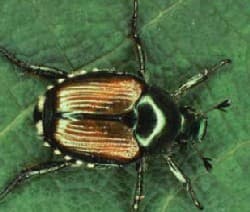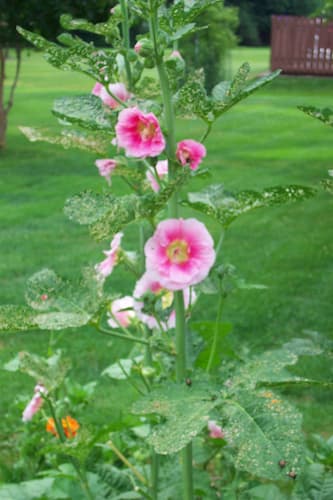Japanese Beetle Lawn and Garden Insect Pest

About Japanese Beetles
If you have Japanese Beetles in your area, you most certainly know it. An infestation of these bugs is quite visible. Japanese beetles aren’t shy. They are readily seen on plants. They can damage the flowers and foliage of plants in a hurry.
The USDA describes Japanese Beetles as a “highly destructive plant pest”. They are the most serious of all lawn pests.
The Japanese Beetle life cycle has two stages. First, is the adult Beetle. They attack the foliage, flowers, or fruit of several hundred species of plants. This includes flowers, vegetables, bushes, trees, and ornamentals. Second, is the larva stage. In this stage the Beetle larva, or “grubs”, feed on the roots of the grass, spending the winter months under your lawn. A large infestation can damage the lawn.
Japanese Beetles came from Japan. They were first discovered in 1916 in Riverton, NJ. Without a natural predator in North America, they spread quickly. They are now found in most states east of the Mississippi River. Infestations have also been found west of the Mississippi.
Popillia Japonica Newman
Identifying Japanese Beetles
Adult Japanese Beetles are a little smaller than 1/2″ long. they have metallic green bodies and bronze wings. The female grows a little larger than the male. They are easy to spot on the leaves of your plants, or in the flowers.
As grubs, they grow to almost an inch and are a whitish color. Turn over some sod, and you will find them at the root line.
Japanese Beetle Life Cycle
Adult Beetles emerge from the ground in late spring to early summer. They spend their time devouring plants. The female burrow underground numerous times to lay eggs. She will lay them about 3 inches below the surface, a few eggs at a time. Over a few weeks, each female will deposit about 40 to 60 eggs in your lawn.
In mid-summer, the eggs hatch, and the grubs begin to feed on the roots of your lawn. At this point, they are only a couple of inches below the surface of the lawn and can be treated with lawn grub killers. In late fall, they burrow down 4-8 inches to overwinter.
In the spring, the grubs return to the roots of grasses to feed. By late spring, they change into pupae. This stage lasts about 2 weeks, before emerging as an adult, flying beetle.

Controlling Japanese Beetles
The picture above is a Hollyhock plant with severe beetle damage.
For adult beetles:
Most chemical sprays, that are available to homeowners, are not strong enough to kill them. Check the label on the insecticides at your local garden store, to see if they are effective against Japanese Beetles.
- Japanese Beetle traps can help reduce their numbers. These traps contain a sex hormone to attract them into the trap.
- You can also pick them off plants. After picking them, make sure to kill them. Don’t just dispose of them in the trash, to later escape.
Controlling Japanese Beetle Grubs.:
Lawn grub killer can be applied when the beetles are feeding on grass roots. Treatment is usually done in mid to late August.
Related Articles
People who read this article also like:
Please support our site. Shop for:
- rmmatthews100@hotmail.com
- 585-721-6528
- Rochester, NY
©1999-2024 GardenersNet.Com, All Rights Reserved

